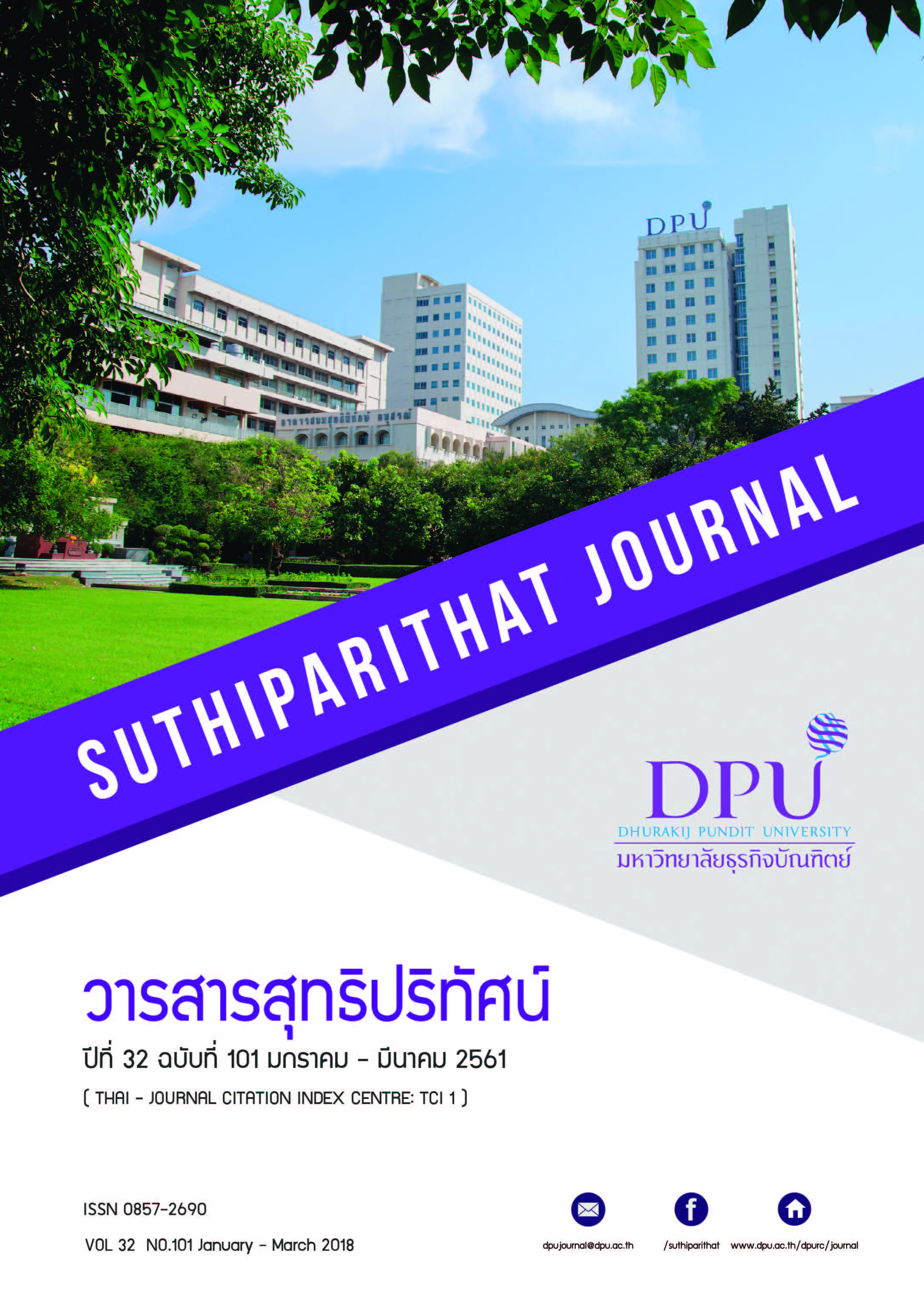ความสัมพันธ์ระหว่างกลไกการกำกับดูแลกิจการที่ดีและ การทุจริตโดยผู้บริหารของบริษัทจดทะเบียน ในตลาดหลักทรัพย์แห่งประเทศไทย
คำสำคัญ:
การทุจริตโดยผู้บริหาร, กลไกการกำกับดูแลกิจการ, คณะกรรมการบริษัท, ผู้ถือหุ้น, คณะกรรมการ ตรวจสอบต้นทุนตัวแทนบทคัดย่อ
ปัญหาของการทุจริตทำให้องค์กรต่างๆ ทั้งในและต่างประเทศต่างตระหนักถึงความเสียหายที่ เกิดขึ้นการศึกษาที่ผ่านมาแสดงให้เห็นว่า กลไกการกำกับดูแลกิจการมีผลกระทบต่อการเกิดทุจริตในองค์กร งานวิจัยครั้งนี้จึงมีวัตถุประสงค์เพื่อศึกษากลไกการกำกับดูแลกิจการที่ดี ที่มีความสัมพันธ์กับการทุจริตโดย ผู้บริหาร ซึ่งได้ทำการศึกษาในด้านกลไกการกำกับดูแลกิจการโดยคณะกรรมการบริษัท โดยคณะกรรมการ ตรวจสอบ โดยผู้ถือหุ้น และโดยต้นทุนตัวแทน บริษัทตัวอย่างที่ใช้ในงานวิจัยแบ่งออกเป็นบริษัทที่มี การทุจริต โดยผู้บริหารจำนวน 64 บริษัท และบริษัทตัวอย่างที่ไม่มีการทุจริต เพื่อ่ใช้ในการเปรียบเทียบจำนวน 64 บริษัท วิธีที่ใช้วิเคราะห์ความสัมพันธ์ได้แก่ การวิเคราะห์ความถดถอยโลจิสติค ผลการศึกษาพบว่า หากขนาดของคณะกรรมการบริษัท การควบตำแหน่งของประธานเจ้าหน้าที่บริหารและประธานกรรมการ สัดส่วนกรรมการบริษัทที่มีความสัมพันธ์ทางการเมือง ข้าราชการ หรือทหารมีมากขึ้น จะส่งผลให้โอกาส ของการเกิดทุจริตโดยผู้บริหารเพิ่มขึ้น ในทางตรงกันข้ามผลการศึกษาพบว่า การมีเลขานุการบริษัทที่มี ความเชี่ยวชาญด้านบัญชีหรือกฎหมายและคะแนนประเมินการกำกับดูแลกิจการเพิ่มขึ้นจะทำให้โอกาสของ การเกิดทุจริตโดยผู้บริหารลดลง แต่อย่างไรก็ตามผลการวิจัยได้แสดงให้เห็นว่า คณะกรรมการตรวจสอบ ผู้ถือหุ้น และต้นทุนตัวแทนไม่มีความสัมพันธ์กับโอกาสของการเกิดทุจริตโดยผู้บริหาร ดังนั้นนักวิชาการ รวมถึงองค์กรที่เกี่ยวข้องควรตระหนักถึงการกำกับดูแลกิจการที่เป็นจุดอ่อนซึ่งอาจนำไปสู่การทุจริตโดย
เอกสารอ้างอิง
เจริญ เจษฎาวัลย์. (2553). การทุจริตทางการบริหารชั้นคลาสสิค Classic Management Fraud. กรุงเทพฯ: บริษัท พอดี จำกัด.
นิพัฒน์ โพธิ์วิจิตร. (2554). ผลกระทบของโครงสร้างผู้ถือหุ้นคณะกรรมการและคณะกรรมการตรวจสอบที่มีต่อการบริหารกำไรของบริษัทจดทะเบียนในตลาดหลักทรัพย์แห่งประเทศไทย (วิทยานิพนธ์ปริญญาบริหารธุรกิจดุษฎีบัณฑิต). กรุงเทพฯ: มหาวิทยาลัยธุรกิจบัณฑิตย์.
ภานุพงษ์ โมกไธสง. (2556). ความสัมพันธ์ระหว่างกลไกการกำกับดูแลกิจการโครงสร้างของผู้ถือหุ้นต้นทุนตัวแทนกับคุณภาพกำไรของกิจการจดทะเบียนในตลาดหลักทรัพย์ของประเทศไทย (ดุษฎีนิพนธ์บริหารธุรกิจดุษฎีบัณฑิต). พิษณุโลก: มหาวิทยาลัยนเรศวร.
ภิญญดาพัชญ์ ชัยจรัสเจริญลาภ. (2558). คุณลักษณะของผู้บริหารสูงสุดและผลการดำเนินงานของบริษัท: กรณีศึกษาบริษัทจดทะเบียนในตลาดหลักทรัพย์แห่งประเทศไทย (การค้นคว้าอิสระหลักสูตรวิทยาศาสตร์มหาบัณฑิต). กรุงเทพฯ: มหาวิทยาลัยกรุงเทพ.
ชิรวัชร งามละม่อม. (2559). รัฐประหาร บทบาททหารกับการเมืองในประเทศไทย, การประชุมวิชาการของมหาวิทยาลัยเกษตรศาสตร์ ครั้งที่ 54 (หน้า 602-610). กรุงเทพฯ: มหาวิทยาลัยเกษตรศาสตร์.
วิชุดา สาธิตพร. (2556). เครือข่ายธุรกิจของนักการเมืองไทย. วารสารสถาบันพระปกเกล้า, 11(2), 24-41.
ศรันยา วิบูลย์ศิริพงษ์. (2549). บทบาทหน้าที่และความรับผิดชอบของเลขานุการบริษัท (วิทยานิพนธ์ปริญญานิติศาสตรมหาบัณฑิต). กรุงเทพฯ: จุฬาลงกรณ์มหาวิทยาลัย.
สำนักงานคณะกรรมการกำกับหลักทรัพย์และตลาดหลักทรัพย์. (2547). คู่มือกรรมการบริษัทจดทะเบียนเล่มที่ 1: บทบาทหน้าที่และความรับผิดชอบของ “กรรมการ” และ “คณะกรรมการ”. สืบค้นเมื่อ 12 กุมภาพันธ์ 2560, จาก https://www.set.or.th
อิสริยา วิมลรัตน์. (2552). การนำบทบัญญัติเกี่ยวกับการบังคับขายหุ้นจากผู้ถือหุ้นรายย่อย (Squeeze Out) มาใช้ในประเทศไทย (วิทยานิพนธ์ปริญญานิติศาสตร์มหาบัณฑิต). กรุงเทพฯ: จุฬาลงกรณ์มหาวิทยาลัย.
Abdallah, A. A., & Ismail, A. K. (2017). Corporate governance practices, ownership structure, and corporate performance in the GCC countries. Journal of International Financial Markets, Institutions & Money, 46, 98–115.
Abdul Wahab, E. A., Gist, W. E., & Nik Abdul Majid, W. Z. (2014). Characteristics of non-audit services and financial restatements in Malaysia. Journal of Contemporary Accounting & Economics, 10 (2014), 225–247.
Agrawal, A., & Chadha, S. (2005). Corporate governance and accounting scandals. Journal of Law and Economics. 48(2), 371-406.
Anderson, R.C. & Reeb, D.M. (2003), Founding-family ownership and firm performance: Evidence from the S&P 500. The Journal of Finance, LVIII (3), 1301-28.
Apostolides, N. (2010). Exercising corporate governance at the annual general meeting. Corporate Governance, 10(2), 140–149.
Association of Certified Fraud Examiners (ACFE). (2016). Report to the Nations on Occupational Fraud and Abuse 2016 Global Fraud Study. Austin, Texas: ACFE.
Baxter, P., & Cotter, J. (2009). Audit Committees and Earnings Quality. Accounting and Finance, 49, 267–290.
Beasley, M.S. (1996). An empirical analysis of the relation between the board of director composition and financial statement fraud. The Accounting Review, 71(4), 443–465.
Beasley, M. S., Carcello, J. V., Hermanson, D. R., & Lapides, P. D. (2000). Fraudulent financial reporting: consideration on industry traits and corporate governance mechanisms. Accounting Horizons, 14(4), 441–454.
Calabrò, A., & Mussolino, D. (2013). How do boards of directors contribute to family SME export intensity? The role of formal and informal governance mechanisms. Journal of Management and Governance, 17, 363–403.
Capezio, A. & Mavisakalyan, A. (2015). Women in the boardroom and fraud: Evidence from Australia. Australian Journal of Management. 41(4), 719 – 734.
Chen, G., Firth, M., Gao, D. N., & Rui, O. M. (2006). Ownership Structure, Corporate Governance, and fraud: Evidence from China. Journal of Corporate Finance, 12(2006), 424-448.
Cheung, Y. L., Connelly, J.T., Limpaphayom, P., & Zhou, L. (2007). Do investors really value corporate governance? Evidence from the Hong Kong market.. Journal of International Financial Management and Accounting, 18, 86-122.
Conyon, M. J., & He, L. (2016). Executive Compensation and Corporate Fraud in China. Journal of Business Ethics, 134, 669–691.
Ding, X., Ni, Y., & Zhong, L. (2016). Free float and market liquidity around the world. Journal of Empirical Finance, 38 (2016), 236–257.
Domadenik, P., Prasnikar, J., & Svejnar, J. (2016). Political Connectedness, Corporate Governance, and Firm Performance. Journal of business ethics, 2016 (139), 411–428.
Efendi, J., Srivastava, A., & Swanson, E. P. (2007). Why do corporate managers misstate financial statements? The role of option compensation and other factors. Journal of Financial Economics, 85(3), 667-708.
Ehikioya, B. I. (2009). Corporate governance structure and firm performance in developing economies: evidence from Nigeria. Corporate Governance, 3(9), 231-243.
Fama, E. F., & Jensen, M. C. (1983). Separation of Ownership and Control. Journal of Law and Economics, 26(2), 301-325.
Farber, D. B. (2005). Restoring Trust after Fraud: Does Corporate Governance Matter?. The Accounting Review, 80(2), 539-561.
Jensen, M. C., & Meckling, W. H. (1976). Theory of the firm: Managerial behaviour, agency costs andownership structure. Journal of Financial Economics, 3(1997), 305–360.
Kakabadse, A., Khan, N., & Kakabadse, N. K. (2016). Company secretary: a role of breadth and Majesty. Society and Business Review, 11(3), 333 – 349.
Markelevich, A., & Rosner, R. L. (2013). Auditor Fees and Fraud Firms. Contemporary Accounting Research, 30(4), 1590–1625.
Mathew, S., Ibrahim, S., & Archbold, S. (2016).Boards attributes that increase firm risk – evidence from the UK. Corporate Governance, 16(2), 233 – 258
McMullen, D. A., & Raghunandan, K. (1996). Enhancing audit committee effectiveness. Journal of Accountancy, 182, 79–81.
Morris, G. D., McKay, S., & Oates, A. (2009), Finance Director’s Handbook, (5th ed.), CIMA Publishing is an imprint of Elsevier, Burlington.
Shan, Y. G., Graves, C, & Ali, H.H . (2013). Effect of Board Composition and Ownership Characteristics on Fraud: Evidence from Malaysian Listed Companies. South East Asia Research, 21(2), 323-342.
Sharma, V. D. (2004). Board of director characteristics, institutional ownership and fraud: Evidence from Australia. Auditing: A Journal of Practice & Theory, 23(2), 105–117.
Stratling, R. (2003). General meetings: A dispensable tool for corporate governance of listed companies? Corporate Governance: An International Review, 11, 74–82.
Uzun, H., Szewczyk, S. H.,& Varma, R. (2004). Board composition and corporate fraud. Financial Analysts Journal, 60(3), 33–43.
Wu, W., Johan, S. A., & Rui, O. M. (2016). Institutional Investors, Political Connections, and the Incidence of Regulatory Enforcement Against Corporate Fraud. Journal of Business Ethics. Apr2016, 134(4), 709-726.
Xie, B., Davidson III, W. N., & Da Dalt, P. J. (2003). Earnings management and corporate governance: the role of the board and the audit committee. Journal of corporate finance, 9, 295-316.
Yermack, D. (1996). Higher market valuation of companies with a small board of directors. Journal of Financial Economics, 40(2), 185-211.
ดาวน์โหลด
เผยแพร่แล้ว
รูปแบบการอ้างอิง
ฉบับ
ประเภทบทความ
สัญญาอนุญาต
เนื้อหาและข้อมูลในบทความที่ลงตีพิมพ์ในวารสารสุทธิปริทัศน์ ถือเป็นข้อคิดเห็นและความรับผิดชอบของผู้เขียนบทความโดยตรงซึ่งกองบรรณาธิการวารสาร ไม่จำเป็นต้องเห็นด้วย หรือร่วมรับผิดชอบใด ๆ
บทความ ข้อมูล เนื้อหา รูปภาพ ฯลฯ ที่ได้รับการตีพิมพ์ในวารสารสุทธิปริทัศน์ ถือเป็นลิขสิทธิ์ของวารสารสุทธิปริทัศน์หากบุคคลหรือหน่วยงานใดต้องการนำทั้งหมดหรือส่วนหนึ่งส่วนใดไปเผยแพร่ต่อหรือเพื่อกระทำการใด ๆ จะต้องได้รับอนุญาตเป็นลายลักษณ์อักษรจากวารสารสุทธิปริทัศน์ก่อนเท่านั้น







